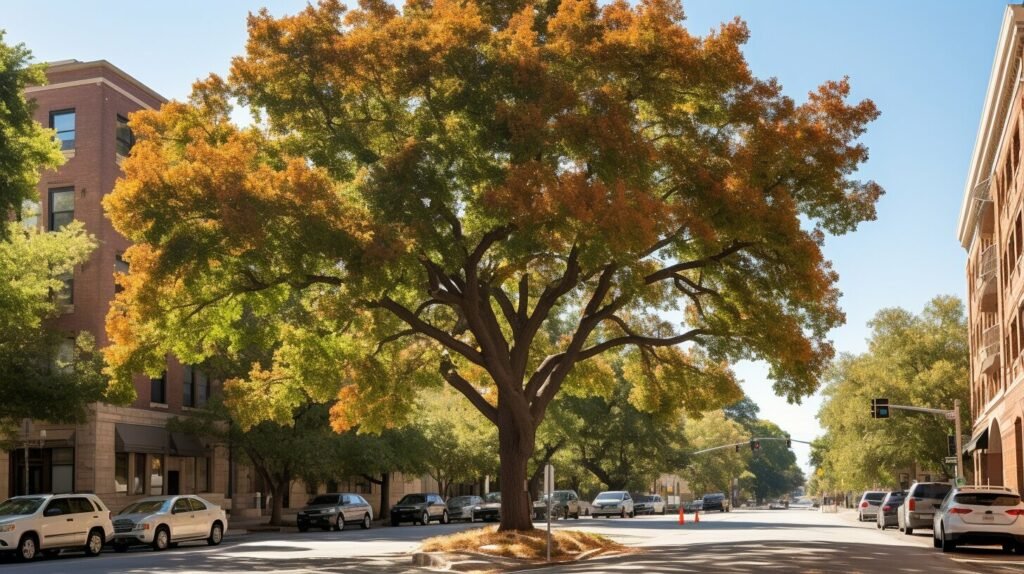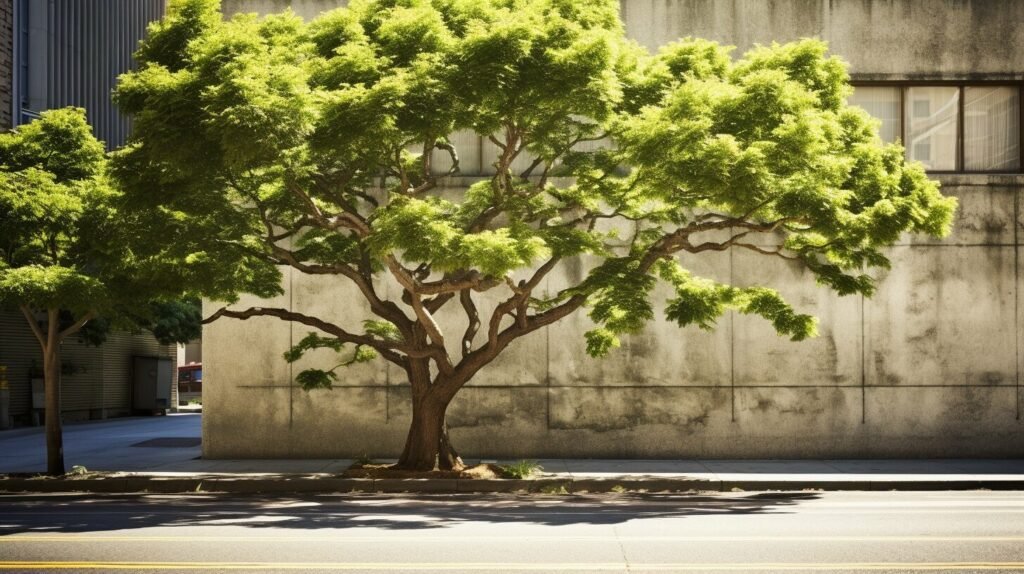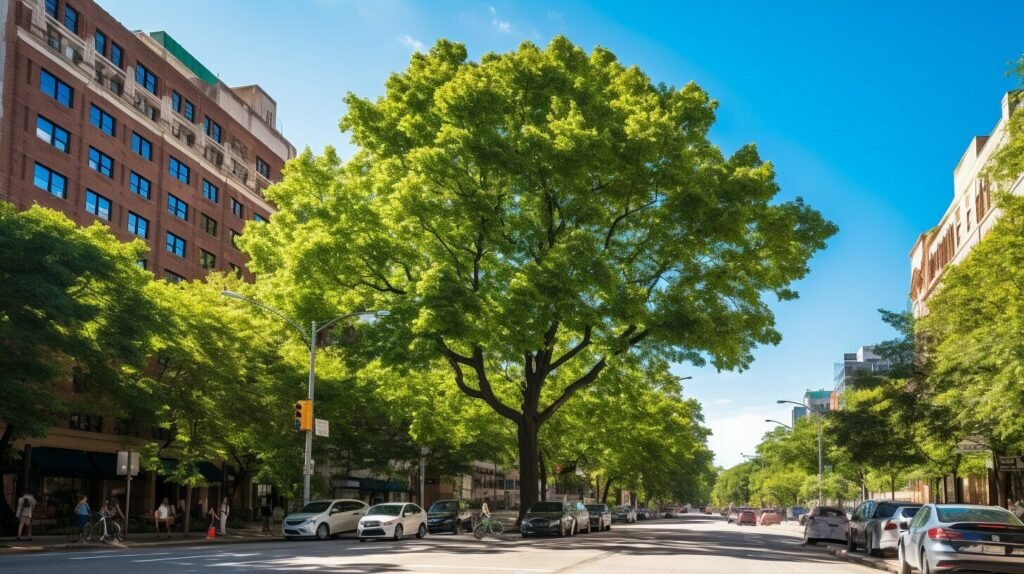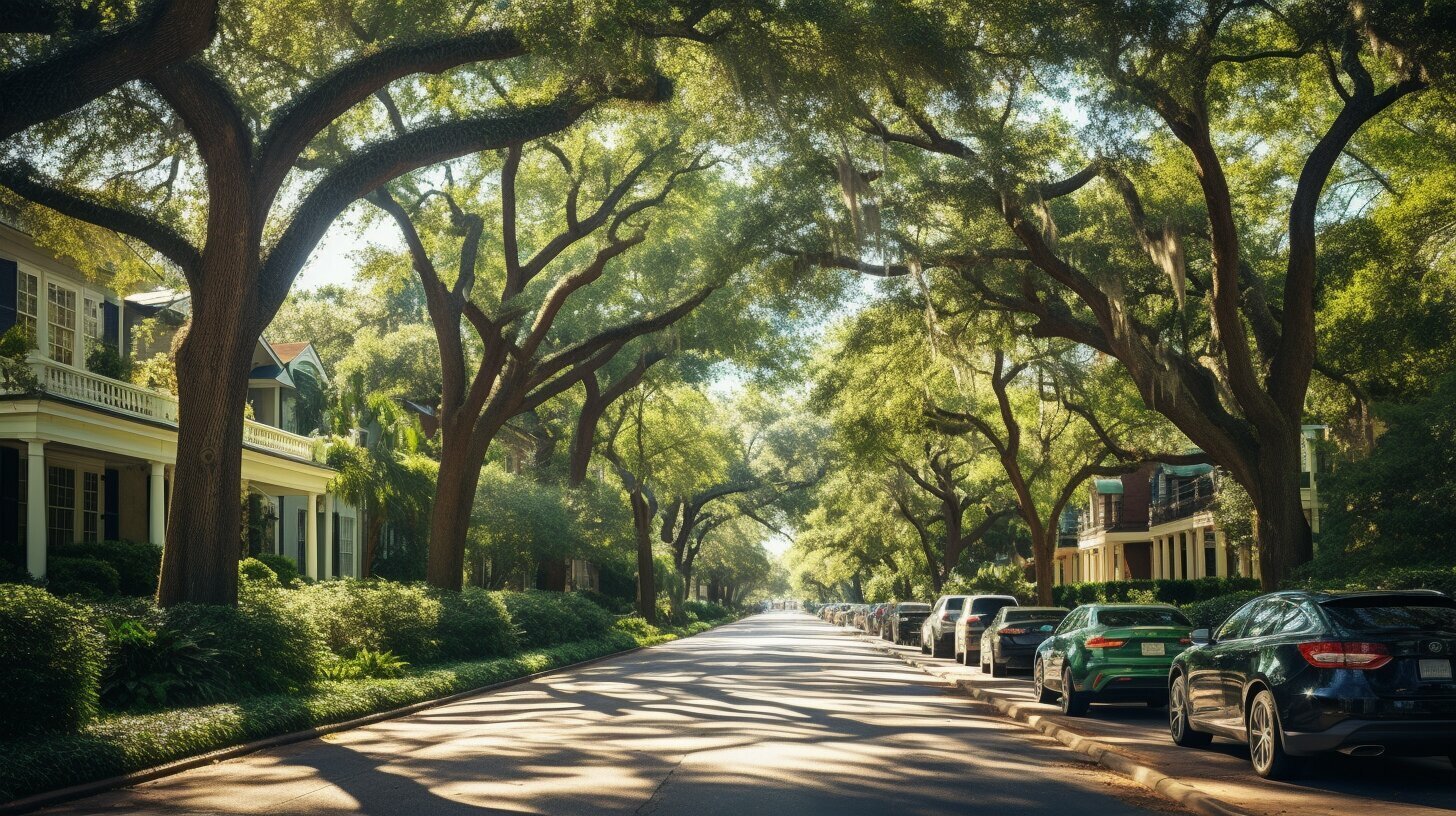Urban oak trees are a beautiful and practical addition to any yard in the city, providing shade and creating a welcoming aesthetic. With their majestic presence and long lifespan, oak trees are a popular choice for urban landscapes throughout the United States. Not only do they enhance the beauty of your yard, but they also contribute to the overall well-being of city dwellers.
Key Takeaways:
- Urban oak trees are a popular choice for their beauty, shade, and longevity.
- There are approximately 500 species of oak trees, with five thriving varieties for urban landscapes.
- The Nuttall oak is known for its fast growth, adaptability, and vibrant fall colors.
- The Japanese evergreen oak is a smaller option ideal for shade and screening.
- The northern red oak offers fast growth and can live up to 500 years.
- The pin oak provides a well-shaped canopy and stunning fall colors.
- The water oak thrives in wet conditions and is a hardy addition to any landscape.
Consider planting one of these oak tree varieties in your yard to enjoy their beauty, shade, and the benefits they bring to urban greenery. The elegance and shade provided by urban oak trees will not only enhance your landscape but also make your yard a welcoming and refreshing space.
The Beauty and Benefits of Urban Oak Trees
Urban oak trees offer more than just shade – their beauty and elegance make them a stunning addition to any urban landscape. With approximately 500 different species to choose from, oak trees are a popular choice for homeowners and city planners alike. These majestic trees not only provide much-needed shade but also enhance the aesthetic appeal of urban landscapes.
One of the key benefits of urban oak trees is their ability to create a sense of tranquility and natural beauty in bustling city environments. The grandeur of their spreading branches and the lush green foliage they exhibit during the warmer months can transform any urban space into a serene retreat. Whether lining city streets or gracing private yards, oak trees bring an instantly recognizable elegance that is hard to match.
Beyond their beauty, oak trees also play a crucial role in urban ecosystems. They provide valuable shade, reducing the effects of the heat island effect in densely populated areas. By absorbing carbon dioxide and releasing oxygen, oak trees contribute to improving air quality. Additionally, their extensive root systems help prevent soil erosion and improve water infiltration, further benefiting the overall health of urban environments.
“Urban oak trees not only provide shade and elegance to our yards, but they also contribute to the well-being of our cities.”
When selecting oak trees for urban landscapes, it’s important to consider their specific characteristics and suitability for the environment. In the following sections, we will explore five oak tree varieties that thrive in urban settings. From the fast-growing Nuttall oak to the adaptable Japanese evergreen oak, each variety offers unique features that make them ideal choices for different urban landscapes.
The Beauty and Benefits of Urban Oak Trees
Urban oak trees offer more than just shade – their beauty and elegance make them a stunning addition to any urban landscape. With approximately 500 different species to choose from, oak trees are a popular choice for homeowners and city planners alike. These majestic trees not only provide much-needed shade but also enhance the aesthetic appeal of urban landscapes.
One of the key benefits of urban oak trees is their ability to create a sense of tranquility and natural beauty in bustling city environments. The grandeur of their spreading branches and the lush green foliage they exhibit during the warmer months can transform any urban space into a serene retreat. Whether lining city streets or gracing private yards, oak trees bring an instantly recognizable elegance that is hard to match.
Beyond their beauty, oak trees also play a crucial role in urban ecosystems. They provide valuable shade, reducing the effects of the heat island effect in densely populated areas. By absorbing carbon dioxide and releasing oxygen, oak trees contribute to improving air quality. Additionally, their extensive root systems help prevent soil erosion and improve water infiltration, further benefiting the overall health of urban environments.
| Benefits of Urban Oak Trees: | |
|---|---|
| Enhance aesthetic appeal | Provide shade and reduce heat island effect |
| Improve air quality | Prevent soil erosion |
| Support diverse wildlife | Add value to properties |
“Urban oak trees not only provide shade and elegance to our yards, but they also contribute to the well-being of our cities.”
When selecting oak trees for urban landscapes, it’s important to consider their specific characteristics and suitability for the environment. In the following sections, we will explore five oak tree varieties that thrive in urban settings. From the fast-growing Nuttall oak to the adaptable Japanese evergreen oak, each variety offers unique features that make them ideal choices for different urban landscapes.

City tree planting and urban forestry initiatives play a crucial role in creating green spaces and improving the livability of cities, and urban oak trees are an essential part of these efforts. As cities continue to grow and expand, it becomes increasingly important to invest in urban greenery to counterbalance the concrete jungle. Trees provide numerous benefits to urban environments, from improving air quality to reducing urban heat island effects. By planting and caring for trees, we can enhance the aesthetic appeal of our cities while also creating healthier and more sustainable communities.
One of the key aspects of urban forestry is the selection and planting of suitable tree species. Oak trees, with their beauty, shade-providing capabilities, and longevity, are an excellent choice for urban landscapes. With approximately 500 different species to choose from, we can find oak varieties that thrive in various climate zones across the United States. By selecting the right oak tree for our cities, we can ensure their successful growth and contribution to the urban ecosystem.
Benefits of Urban Oak Trees
- Shade: Oak trees have a wide canopy that provides excellent shade, making them ideal for urban landscapes where cooling effects are desired.
- Wildlife Support: Oak trees support a diverse range of wildlife, from birds to insects to mammals, creating a healthier and more balanced urban ecosystem.
- Property Value: Having oak trees in your landscape can increase property value, as they are regarded as valuable assets due to their beauty and longevity.
- Erosion Control: The deep root systems of oak trees help stabilize soil, reducing erosion and preventing landslides in hilly urban areas.
- Environmental Impact: Urban oak trees contribute to carbon sequestration, reducing greenhouse gas emissions and mitigating the effects of climate change.
By understanding the importance of city tree planting and urban forestry, we can take an active role in creating greener and more sustainable cities. Whether it’s planting an oak tree in your own yard or supporting community tree planting programs, every effort counts. Let’s embrace the beauty and shade of urban oak trees and make our cities more vibrant, resilient, and livable.
| Oak Tree Variety | Main Features | Suitability |
|---|---|---|
| Nuttall Oak | Fast growth rate, adaptability, vibrant fall colors | Thrives in various soil conditions |
| Japanese Evergreen Oak | Small size, dense growth habits | Great for shade and screening in smaller yards |
| Northern Red Oak | Fast growth rate, longevity up to 500 years | Versatile choice for urban settings |
| Pin Oak | Well-shaped canopy, beautiful fall colors | Excellent for providing shade |
| Water Oak | Thrives in wet conditions, hardy | Suitable for challenging urban environments |

Thriving Varieties: Oak Trees for Urban Landscapes
When choosing oak trees for your urban landscape, it’s important to select varieties that can thrive in city conditions and add beauty to your surroundings. Oak trees are a popular choice due to their magnificent presence, longevity, and the numerous benefits they bring to urban environments. In this section, we will explore five oak tree varieties that are well-suited for urban landscapes within hardiness zones 4b to 9b in the United States.
Nuttall Oak: Fast Growth, Versatility, and Vibrant Colors
| Growth Rate | Soil Conditions | Fall Colors |
|---|---|---|
| Fast | Adaptable | Vibrant |
The Nuttall oak is a popular choice for urban landscapes due to its fast growth rate, adaptability to various soil conditions, and stunning fall colors. This variety can quickly establish itself and provide shade to your yard. Its adaptability to different soil types, including wet areas, makes it a versatile option for urban environments.
Japanese Evergreen Oak: Small Size, Dense Growth for Shade and Screening
| Size | Growth Habits | Benefits |
|---|---|---|
| Small | Dense | Shade and Screening |
The Japanese evergreen oak is an excellent choice for smaller urban landscapes. Despite its smaller size, it provides dense growth that can create effective shade and serve as a privacy screen. Its ability to retain its leaves year-round adds to its appeal, ensuring greenery even during the winter months.
Northern Red Oak: Fast Growth and Longevity for Urban Settings
| Growth Rate | Longevity | Suitability |
|---|---|---|
| Fast | Up to 500 years | Urban Settings |
The northern red oak is a versatile variety that thrives in urban settings. Its fast growth rate makes it an ideal choice for those looking to establish a tree quickly. Moreover, its impressive lifespan of up to 500 years ensures that future generations can enjoy its beauty and benefits.
Pin Oak: Well-Shaped Canopy and Beautiful Fall Colors for Shade
| Canopy Shape | Fall Colors | Benefits |
|---|---|---|
| Well-Shaped | Beautiful | Shade |
The pin oak is an excellent choice for those seeking a well-shaped canopy and vibrant fall colors. Its distinct branching structure creates a picturesque silhouette, enhancing the overall aesthetic of your urban landscape. Furthermore, its stunning fall foliage adds a touch of beauty to your surroundings.
Water Oak: Thriving in Wet Conditions for Hardy Urban Landscapes
| Adaptability | Hardiness | Benefits |
|---|---|---|
| Wet Conditions | Hardy | Urban Landscapes |
The water oak is a hardy variety that thrives in wet conditions, making it an excellent addition to urban landscapes that experience high moisture levels. Its adaptability to different soil types and ability to withstand challenging environments make it a reliable choice for creating a resilient and beautiful urban landscape.

Nuttall Oak: Fast Growth, Versatility, and Vibrant Colors
The Nuttall oak is a popular choice for urban landscapes due to its fast growth rate, versatility, and stunning fall foliage. This oak tree variety is known for its ability to adapt to various soil conditions, making it suitable for a wide range of urban environments. Whether your yard has clay, loam, or sandy soil, the Nuttall oak can thrive and add beauty to your landscape.
Not only does the Nuttall oak grow quickly, but it also offers vibrant colors during the fall season. The leaves turn a striking mix of red, orange, and yellow, creating a stunning display that adds warmth and visual appeal to any urban garden. This makes the Nuttall oak an ideal choice for homeowners looking to enhance the aesthetic of their yards.
When it comes to providing shade, the Nuttall oak does not disappoint. Its dense canopy of foliage offers ample shade, creating a cool and comfortable environment for outdoor activities on hot summer days. This natural shade can help reduce energy costs by keeping your home cooler, making the Nuttall oak a practical and eco-friendly addition to your urban landscape.

For those looking to support wildlife, the Nuttall oak is a fantastic choice. Its acorns provide a valuable food source for various species of birds, squirrels, and other wildlife. By planting a Nuttall oak in your yard, you can contribute to the biodiversity of your urban environment and create a haven for local wildlife.
Key Features of the Nuttall Oak:
- Fast growth rate, quickly establishing itself in urban landscapes
- Adaptable to various soil conditions, including clay, loam, and sandy soil
- Vibrant fall foliage with red, orange, and yellow leaves
- Dense canopy that provides ample shade
- A valuable food source for birds and wildlife
Consider adding the Nuttall oak to your urban landscape to enjoy its fast growth, adaptability, and stunning fall colors. Whether you’re looking to enhance the beauty of your yard, create a shaded retreat, or support local wildlife, this versatile oak tree variety is an excellent choice.
Next, we’ll explore another variety of oak tree that is perfect for providing shade and screening in urban landscapes: the Japanese evergreen oak.
Japanese Evergreen Oak: Small Size, Dense Growth for Shade and Screening
If you’re looking for a compact oak tree that provides ample shade and serves as an effective screen, consider the Japanese evergreen oak for your urban landscape. This small-sized oak tree variety is an ideal choice for homeowners who have limited space but still want the benefits that oak trees offer.
The Japanese evergreen oak is known for its dense growth habits, which allow it to create a thick canopy that provides shade and privacy. Whether you’re looking to create a cozy outdoor seating area or block out unsightly views, this oak tree variety can fulfill those needs.
Not only does the Japanese evergreen oak offer practical benefits, but it also adds beauty to your landscape. With its glossy, dark green leaves that remain on the tree year-round, this oak tree will provide visual interest and a touch of elegance to your urban setting.

In addition to its aesthetic appeal and shade-providing capabilities, the Japanese evergreen oak is known for its ability to withstand urban environments. It is tolerant of pollution, compacted soil, and drought, making it a hardy choice for city dwellers. This oak tree variety can adapt to a wide range of soil types, including clay and loam, further adding to its suitability for urban landscapes.
By planting the Japanese evergreen oak in your yard, you can enjoy the many benefits it offers. Not only will it provide shade, privacy, and beauty, but it will also support a diverse range of wildlife and contribute to the overall health of your ecosystem. Consider adding this compact oak tree to your urban landscape and enjoy its dense growth habits for years to come.
Northern Red Oak: Fast Growth and Longevity for Urban Settings
The northern red oak is a reliable choice for urban landscapes, offering fast growth and impressive longevity that ensures its beauty will endure for generations. With a rapid growth rate, this majestic oak tree can quickly establish itself in your yard, providing shade and enhancing the aesthetic appeal of your urban landscape. The northern red oak is known for its strong and sturdy branches, which can withstand harsh weather conditions and urban stresses.
One of the standout features of the northern red oak is its impressive longevity. These trees can live up to 500 years, making them a true investment for your landscape. Their durability and resilience make them an ideal choice for urban settings, where they can thrive and add value to your property for decades to come.
Not only does the northern red oak offer visual beauty and long-term value, but it also supports a diverse range of wildlife. The acorns produced by these trees provide an important food source for squirrels, chipmunks, and birds. The dense canopy of the northern red oak offers shelter and nesting opportunities for various avian species. By planting a northern red oak in your urban landscape, you are creating a habitat that supports biodiversity and contributes to the overall health of your local ecosystem.

In conclusion, the northern red oak is a remarkable tree that brings both aesthetic and ecological benefits to urban landscapes. Its fast growth rate, impressive longevity, and wildlife-supporting capabilities make it an ideal choice for homeowners looking to enhance their yards. Consider planting a northern red oak in your landscape to enjoy its beauty and shade for years to come.
Pin Oak: Well-Shaped Canopy and Beautiful Fall Colors for Shade
The pin oak is a standout choice for shade in urban landscapes, with its well-shaped canopy and breathtaking display of fall colors. This majestic oak tree variety adds an elegant touch to any yard, while also providing much-needed shade during the sweltering summer months. Its strong, symmetrical branches form a dense canopy, creating a cool and inviting space underneath.
One of the most striking features of the pin oak is its vibrant fall foliage. As the seasons change, the leaves transform into a mesmerizing array of deep reds, brilliant oranges, and golden yellows. This stunning display of colors adds warmth and beauty to urban landscapes, creating a picturesque scene that is sure to captivate passersby.
The pin oak is highly adaptable and thrives in a variety of soil conditions, making it well-suited for urban environments. It is a fast-growing tree, reaching heights of up to 60-70 feet, providing ample shade and privacy to your yard. With its well-shaped canopy and beautiful fall colors, the pin oak is not only a practical choice for shade but also a visually striking addition to any landscape.
Benefits of Planting the Pin Oak:
- Provides excellent shade for outdoor activities and relaxation.
- Enhances the aesthetic appeal of urban landscapes with its well-shaped canopy and vibrant fall colors.
- Contributes to the overall well-being of city dwellers by improving air quality and reducing urban heat island effect.
- Supports a diverse range of wildlife, including birds and squirrels.
- Adds value to your property through its beauty and longevity.
Consider adding the pin oak to your landscape to enjoy its shade, beauty, and environmental benefits. Its well-shaped canopy and stunning fall colors will create a visually pleasing and relaxing outdoor space for years to come.

For urban landscapes with wet conditions, the water oak is a hardy and adaptable choice that can withstand challenging environments. This oak tree variety, known for its resilience, thrives in areas where other trees struggle to survive. With its ability to tolerate standing water and wet soils, the water oak is a perfect addition to parks, gardens, and residential landscapes in urban areas.
One of the key features of the water oak is its adaptability to different soil types. Whether the soil is clay, loam, or sandy, this oak tree variety can thrive and continue to flourish. Its deep root system enables it to access water and nutrients even in saturated soils, making it an excellent choice for areas prone to flooding or heavy rainfall.
The water oak not only provides shade and beauty but also supports a diverse range of wildlife. Its acorns are a valuable food source for squirrels, deer, and a variety of bird species. Additionally, the dense canopy of the water oak offers nesting sites and shelter for birds, contributing to the biodiversity of urban landscapes.
| Growth Habits | Hardiness Zones | Fall Colors |
|---|---|---|
| Medium to fast | 4b to 9b | Brown |
With its ability to thrive in wet conditions, the water oak adds value and beauty to urban landscapes. Whether you have a yard, a park, or a garden, consider planting a water oak to enjoy its resilience, shade, and contribution to the local ecosystem. Introduce the water oak into your landscape and witness the transformation of your urban environment.

Urban oak trees provide a touch of elegance, shade, and value to your property, making them an excellent addition to any urban landscape. These majestic trees not only enhance the aesthetic appeal of your yard, but they also offer numerous benefits for city dwellers.
With approximately 500 different species of oak trees, there are several varieties that thrive in urban settings. In this article, we have focused on five oak tree varieties that are well-suited for urban landscapes within the United States. These varieties fall within hardiness zones 4b to 9b, ensuring their adaptability to different climates.
The Nuttall oak is a standout choice with its fast growth rate, adaptability to various soil conditions, and vibrant fall colors. Whether you have clay or sandy soil, this oak tree will flourish and provide a stunning display of colors during the autumn season.
If you’re looking for a smaller oak tree option that still offers shade and screening, the Japanese evergreen oak is an excellent selection. Its dense growth habits make it ideal for smaller yards in urban settings, providing both privacy and a cool respite from the summer heat.
The northern red oak is a versatile choice for urban landscapes, thanks to its fast growth rate and impressive longevity. With proper care, these trees can live up to 500 years, providing beauty and shade for generations to come.
The pin oak, known for its well-shaped canopy and beautiful fall colors, is another popular shade tree option. Its elegant presence and vibrant foliage make it a stunning addition to any landscape, adding visual interest and natural beauty.
Lastly, the water oak is a hardy variety that thrives in wet conditions. If you have a landscape prone to flooding or areas with poor drainage, this oak tree will thrive and add resilience to your yard.
Planting an oak tree in your urban landscape not only adds beauty and shade, but it also supports a diverse range of wildlife. From birds to squirrels, these majestic trees provide a habitat for various creatures, enhancing the biodiversity of your surroundings.
So, whether you’re looking to add elegance to your yard, create a shaded retreat, or increase the value of your property, consider planting one of these oak tree varieties in your landscape. You’ll enjoy the beauty and shade of urban oak trees for years to come.
FAQ
Q: Why are oak trees a popular choice for urban landscapes?
A: Oak trees are popular in urban landscapes due to their beauty, shade-providing capabilities, and longevity.
Q: How many different species of oak trees are there?
A: There are approximately 500 different species of oak trees.
Q: What are the hardiness zones for the oak tree varieties discussed in this article?
A: The oak tree varieties discussed in this article thrive in hardiness zones 4b to 9b.
Q: What are the specific features of the Nuttall oak?
A: The Nuttall oak is known for its fast growth rate, adaptability to various soil conditions, and vibrant fall colors.
Q: Why is the Japanese evergreen oak a great option for urban landscapes?
A: The Japanese evergreen oak, although smaller in size, is a great option for shade and screening due to its dense growth habits.
Q: What makes the northern red oak a versatile choice for urban settings?
A: The northern red oak has a fast growth rate and can live up to 500 years, making it a versatile choice for urban settings.
Q: What are the notable features of the pin oak?
A: The pin oak has a well-shaped canopy and displays beautiful fall colors, making it another great shade tree option for urban landscapes.
Q: What are the characteristics of the water oak?
A: The water oak thrives in wet conditions and is a hardy addition to any urban landscape.
Q: How do oak trees benefit urban landscapes?
A: Oak trees provide a majestic presence, add value to properties, and support a diverse range of wildlife in urban landscapes.
Q: Why should I consider planting one of these oak tree varieties in my landscape?
A: Planting one of these oak tree varieties will allow you to enjoy their beauty and shade for years to come.




